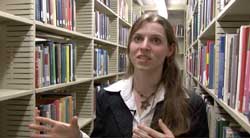Filed Under > Convocation
Home is Where the Push Pin Is
Brittany Lynk has been outward bound since she was a kid, but family and community remain her touchstones
Brittany Lynk has been outward bound since she was a kid, but family and community remain her touchstones
Brittany Lynk, who is receiving her TC master’s degree in International Educational Development, has known since she was an eight-year-old at summer camp that she was interested in meeting people from different backgrounds and cultures. In “Now Boarding,” the “educational autobiography” she compiled for her integrated final project in Family and Community Education, Lynk recalls that her world “expanded and flourished in the search for life’s realities in the stories of these new friends bringing profound insights of how to live, love, and find purpose and hope.”
Yet it was during a first-year cultural anthropology course at Macalester College that Lynk—who grew up in Wadena, Minnesota, a tiny town of 4,000 souls, where her grandparents and uncles had run a hardware store for nearly 70 years—found her true calling. Assigned by the course’s professor, Jack Weatherford, to design and implement a project that helped children in Mongolia in some tangible way, Lynk and her classmates created a children’s book that related, in both English and Mongolian, the story of the American folk character Pecos Bill. The book was successfully distributed in Mongolia, and Lynk had discovered her métier, on three different levels: international exchange, graphic design and, above all, education.
The most immediate outcome of that project was she and classmates subsequently produced two more children’s books: Doorways to the World, Doorways to Ourselves, which includes stories from the United States, Mongolia, Lesotho and Jamaica, and The Tale of Why the Moon is Free, a Mexican folktale. Both books have been distributed to schools, libraries and orphanages in those countries.
Longer-term, Lynk has since embarked on a non-stop world tour that has taken her to four continents and nearly 30 countries. Her stops have included Ghana, where she worked as a community engagement leader at the Kokrobitey Institute, which opens the nation’s cultural, historical, and intellectual resources to students from abroad (Lynk hosted Al Sharpton and Cornel West); Albania, where she worked for USAID liaising with contractors in agro-entrepreneurship, women’s empowerment and community development; Nepal, where she mentored leaders from Youth Managed Resource Centers; and Jamaica, where she teamed with fellow Macalester alumni to start a non-governmental organization call JaMinn Link, aimed at increasing the direct engagement of Jamaicans at home and abroad in dealing with violence, unemployment and access to quality education.
It’s the resume of a certified rolling stone, to be sure – but Lynk writes in “Now Boarding” that “No matter the locale, the small-town girl in me comes out, always rooted in the family unit, the very core of every community.”
At TC, the heart of her work has been the family and community studies program led by Hope Leichter. The coursework has focused both on personal memory and creative intelligence, as well as research on families and communities of others, but Lynk has applied the family and community lens in other subject areas as well. In an “Economics of Education” course with Francisco Rivera-Batiz, for example, she studied cash transfer programs, which give parents in poor rural communities financial incentives to send their children to school. Lynk explored the impact these programs have on families in the context of the community rather than only looking at the larger impact on local or regional economies. In “Aesthetics of Education,” with Maxine Greene, she explored the role of family and community in identity formation and imagination.
All of these interests and experiences have come together in Lynk’s final project for Leichter, a one-day interactive exhibit she presented at TC at the end of April called “The MeYouZeum: (Re)Imaginings of Home and Identity.”
Staged with the help of Martta Sareva, a first-year masters International Education student, and Yigal Kotler, a doctoral student at Jewish Theological Seminary, the MeYouZeum featured “learning stations” that explored notions of home and identity, challenging visitors to contemplate questions such as Who am I? Who do others think I am? Who am I becoming? One station displayed objects associated with memories of food; another explored the subtext of typical questions people ask each other when they first meet (“What do you do?” “Where are you from?”) and suggested alternatives; and still another furnished a "Grafitti Tree Wall," with paint, for recording childhood memories. The MeYouZeum also featured a full-sized Mongolian ger—a portable, wood-framed dwelling (in this case, consisting of tables and sheets)—to remind participants that there are multiple concepts of "home."
As Lynk’s program at TC wraps up, so does her student position with the Office of International Visitors through the U.S. Department of State’s Bureau of Educational and Cultural Affairs in New York City. Then it’s off to sub-Saharan Africa for an eight-week stint with ThinkImpact as an Innovation Institute Advisor; then back to New York City. Longer-term, she hopes to continue to work in cultural exchange programming. She’s not sure about her exact trajectory, but then, perhaps the best metaphor for Lynk’s approach to life is the “Chronologies of Place” exhibit that comprised still another exhibit in her MuYouZeum. In it, participants put pins connected by threads on a world map to show different locations where they’d lived or traveled. Under each pin they could tack “emotion” or “story” cards to show that “home is here,” or that they’d found inspiration here, or gone to school here, or learned about death there.
Thinking of Lynk’s story, one imagines a story of connections – a cross hatching of threads so thick and complex, melded with all the lives of the families and communities who welcomed her so warmly along the way, that it would be hard to see the map beneath.
Published Monday, May. 14, 2012
